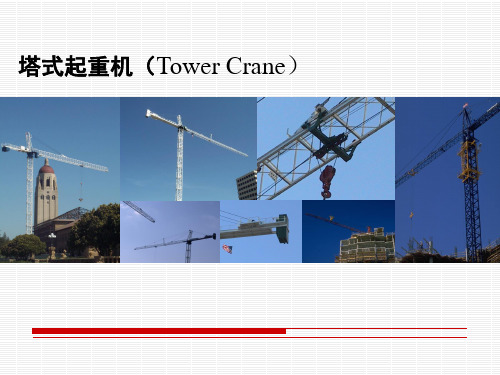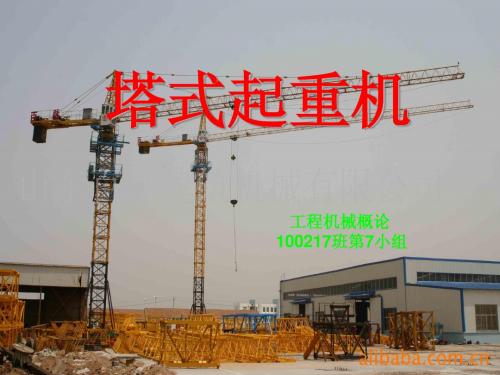塔式起重机英文简介
- 格式:doc
- 大小:38.50 KB
- 文档页数:6


特种设备名词术语起重机械特种设备名词术语-起重机械2. 设备分类及主要零部件2.5 起重机械(lifting appliances)以间隙、重复⼯作⽅式,通过起重吊钩或其他吊具起升、下降或升降与运移重物的机械设备。
2.5.1 梁式起重机(overhead crane with simple girder)起重⼩车在⼯字形梁或其他简单梁上运⾏的简易桥式起重机。
2.5.1.1 电动单梁起重机(electric overhead crane with single girder)起重⼩车在单根⼯字形梁或其他简单梁上运⾏的梁式起重机。
2.5.1.2 电动单梁悬挂起重机(electric underslung crane with single girder)沿悬挂在⼚房屋顶结构上的轨道运⾏的梁式起重机。
2.5.1.3 柔性组合式悬挂起重机(flexible composite underslung crane)其主要受⼒结构是由冷轧型钢轨道或压铸铝合⾦型材轨道组合⽽成的各类简易起重机。
2.5.1.4 防爆梁式起重机(overhead explosion-proof crane with single girder)⽤于易燃、易爆介质的车间中,具有防爆特性的梁式起重机。
2.5.2 桥式起重机(overhead travelling crane)桥架两端通过运⾏装置直接⽀承在⾼架轨道上,取物装置悬挂在可沿桥架运⾏的起重⼩车上的起重机。
2.5.2.1 通⽤桥式起重机(general purpose overhead crane)普通⽤途的桥式起重机,它的吊具是吊钩、抓⽃及电磁吸盘中的⼀种或同时⽤其中的⼆、三种。
2.5.2.2 电站桥式起重机(overhead crane for power station)⽤于发电站的桥式起重机。
2.5.2.3 防爆桥式起重机(overhead explosion-proof crane)⽤于易燃、易爆介质的车间中,具有防爆特性的桥式起重机。


起重机分类:(crane类)moblie crane移动式起重机truck crane汽车式起重机wheel crane / wheeled crane轮胎起重机crawler crane / caterpillar crane履带吊;履带式起重机tower crane塔吊; 塔式起重机-construction tower cranes / building tower crane建筑塔式起重机,建筑塔机-luffing jib tower crane动臂塔式起重机-tower jib crane塔式挺杆起重机(含义与上同)bridge crane/traveling crane/overhead crane桥吊;桥式吊车; 桥式起重机-electric traveling crane电动桥式起重机(俗称行车、天车)-electric double-beam bridge crane电动双梁桥式起重机portal crane / portal bridge crane门式起重机- semi-goliath crane半门式起重机- semi-portal bridge crane半龙门起重机gantry cranes龙门起重机- rubber tyred gantry crane轮胎式龙门吊- electric gantry crane电动龙门式起重机- hook gantry crane吊钩龙门吊- economical gantry crane简单龙门起重机; 简易龙门起重机- rubber tyred container gantry crane 轮胎式集装箱龙门起重机barges / floating Cranes船式起重机; 浮吊; 浮式起重机水上起重机boom crane吊杆起重机; 桁梁起重机; 臂式起重机; 伸臂起重机bucket crane料罐起重机; 吊斗起重机building crane建筑起重机cable crane索道起重机; 缆索起重机container crane集装箱起重机electric crane电动吊车; 电动起重机; 电力起重机electriomagnet crane电磁铁起重机electric jib crane电动单臂起重机fixed crane固定式起重机climbing crane爬升式起重机;攀爬式起重机fixed derrick crane固定式动臂起重机fixed jib crane固定式悬臂起重机flying crane helicopter起重直升机hoist crane起重葫芦hoisting crane升降起重机hook type crane钩式起重机twin hood crane双钩吊车mobile crane移动式吊车; 移动式起重机quay crane码头起重机; 码头桥式起重机; 港岸起重机revolving track crane回转式轨道起重机circular crane旋转式吊车环形吊车roof crane屋顶起重机transporter crane桁架式起重机electric crane电动吊车; 电动起重机gasoline crane汽油起重机hydraulic crane 液力起重机; 液压起重机derrick crane 人字扒杆人字起重机-travelling derrick crane 移动式人字扒杆jib crane/cantilever crane悬臂式起重机wall crane壁式起重机heavy duty crane 重型起重机crane output / carrying capacity of crane / lifting capacity of crane 吊车起重能力crane load 起重机起重量; 起重机起重量crane rating 起重机定额; 起重机载重量crane radius 起重机起吊半径; 起重机伸臂活动半径; 起重机伸距craneage 吊车工时crane beam行车梁起重机大梁crane stair起重机楼梯hoist drive mechanism起重机驱动机构travelling crab起重机小车hoisting controller起重控制器吊车控制手柄hoisting facility起重设施lifting gear起重装置crane (runway) girder吊车梁crane support wall吊车支承墙crane boom起重机吊架; 起重架; 吊车臂; 吊车起重扒杆; 吊杆crane column吊车柱crane hook / grab (or lift hook)( or dolly)起重机吊钩crane jib 起重机吊杆crane bridge起重机桥crane buffer吊车缓冲器crane rope / crane cable起重钢绳; 起重机吊索; 吊车钢丝绳crane carriage起重小车; 横行小车crane carrier起重机载运车crane controller起重控制器crane fall起重机索crane motor / crane hoist type motor起重机电动机crane platform起重机平台crane rail吊车轨,起重机轨道crane runner吊车司机crane runway起重机走道; 天车滑道crane weigher吊车秤crane wheel吊车车轮crane winch起重机绞车lifting tackle起重滑车lever of crane起重机臂hoisting tools起重工具吊具lifting rope吊绳起重钢丝绳起重吊装术语:hoist / load up 起升lower / load down 下降hoist slowly / load up slowly 微微起升lower slowly / load down slowly 微微下降use main hoist/use main line 使用主钩use whip hoist/use whip line 使用小钩raise boom / boom up(臂架类吊车)抬起主臂lower boom / boom down (同上)降下主臂raise boom slowly / boom up slowly(臂架类吊车)微微抬起主臂lower boom slowly / boom down slowly (同上)微微降下主臂swing (根据指挥手势、旗语或)移动摆动stop 停止Emergency stop 紧急停止Extend boom / extend hydranlic boom (汽车吊类)伸长主臂Retract boom / shorten hydranlic boom (汽车吊类)缩回主臂raise the boom and lower the load /boom up and load down (汽车吊类)抬主臂降主钩(俗称顿杆松钩)lower the boom and raise the load /boom dwon and load up (汽车吊类)降主臂起主钩(俗称趴杆起钩)turn left 向左转turn right 向右转。

塔吊塔式起重机(tower crane)简称塔吊,在施工机械中,一般指机身为塔架式结构的全回转动臂架式起重机,为大型土木工程建筑地盘内常见的运输工具,建筑材料、建筑机械搬运,上高落低、纵横交错方向也可以,物件移动的任务能够迅刻完成。
塔式起重机通常约有10层楼高,呈“寸”字形,一端用来吊运物件,中间为控制室,另一端则以巨型混凝土块确保平衡。
由于结构有点像秤,所以在香港也俗称为天秤(“秤”音“称”)。
而塔式起重机会被固定在建筑物中心,以便将物件搬到不同位置和高度。
1 基本介绍塔吊是建筑工地上最常用的一种起重设备,以一节一节的接长(高),好像一个铁塔的形式,还叫塔式起重机,用来吊施工用得钢筋、木楞、脚手管等施工原材料的设备。
是建筑施工一种必不可少的设备。
塔吊(tower crane)尖的功能是承受臂架拉绳及平衡臂拉绳传来的上部荷载,并通过回转塔架、转台、承座等的结构部件式直接通过转台传递给塔身结构。
自升塔顶有截锥柱式前倾或后倾截锥柱式、人字架式及斜撑架式。
凡是上回转塔机均需设平衡重,其功能是支承平衡重,用以构成设计上所要求的作用方面与起重力矩方向相反的平衡力矩。
除平衡重外,还常在其尾部装设起升机构。
起升机构之所以同平衡重一起安放在平衡臂尾端,一则可发挥部分配重作用,二则增大绳卷筒与塔尖导轮间的距离,以利钢丝绳的排绕并避免发生乱绳现象。
平衡重的用量与平衡臂的长度成反比关系,而平衡臂长度与起重臂长度之间又存在一定比例关系。
平衡重量相当可观,轻型塔机一般至少要3~4t,重型的要近30t。
2 历史发展塔式起重机简称塔机,亦称塔吊,起源于西欧。
据记载,第一项有关建筑用塔机专利颁发于1900年。
1905年出现了塔身固定的装有臂架的起重机,1923年制成了近代塔机的原型样机,同年出现第一台比较完整的近代塔机。
1930年当时德国已开始批量生产塔机,并用于建筑施工。
1941年,有关塔机的德国工业标准DIN8770公布。

塔式起重机基本知识第一章塔式起重机(tower crane),简称塔机或塔吊,为什么叫塔式起重机呢?因为早期的塔式起重机设样子设计的像铁塔,因而得名为“塔式起重机”。
现代的塔机除了塔身钢构件,已经很难看出铁塔的样子了。
塔式起重机很多人都见过了,网上也有一些,但有误区,大家都把建筑塔机和塔机搞混淆了。
我们常见的是房屋建筑中的建筑塔机,故有建筑吊之称。
建设部原来出了一个规范《塔式起重机分类》(JG/T-5037-1993),又帮着大家把概念搞得更乱了,要知道,建筑塔机只是塔式起重机其中的一个分支,而且分类方法不是很严格。
就好比我们日常中说吃点肉,这个肉多半是指猪肉,但肉的种类很多,你可以说猪肉是肉,但不能说肉就是猪肉。
塔机的种类也很多,若按有无行走机构分,有固定式和运行式;若按塔身结构划分有上回转式、下回转式、自身附着式三类;若按变幅方式划分,有小车变幅式、动臂变幅式和折臂变幅式三类;若按起重量划分,有轻型、中型与重型三类。
塔式起重机具有适用范围广、起升高度高、回转半径大、工作效率高、操作简便、运转可靠等特点,正因为如此,在各个领域应用广泛。
本来要援引《塔式起重机分类》(JG/T-5037-1993),但考虑到作为建筑行业的行业标准,该标准仅适用于建筑塔式起重机,其他行业的塔式起重机并未参照该标准。
因此,我们还是从广义的塔式起重机范围来讲解。
一、塔式起重机的分类(一) 按有无行走机构分1.固定式固定式塔式起重机:通过联接件将塔身基架固定在地基基础或结构物上,进行起重作业的塔式起重机。
2)移动式塔式起重机具有运行装置,可以行走的塔式起重机。
根据运行装置的不同,又可分为轨道式、轮胎式、汽车式、履带式。
(二)按塔身结构分类1. 上回转塔式起重机我们常见的塔式起重机大多是上回转式塔机,包括城市里常见的建筑类塔机。
上回转塔式起重机将回转支承,平衡重等主要机构均设置在上端,工作时塔身不回转,而是通过支承装置安装在塔顶上的转塔(起重臂、平衡臂及塔帽等组成)旋转。
Tower crane1.Introduction to How Tower Cranes WorkTower cranes are a common fixture at any major construction site. They're pretty hard to miss -- they often rise hundreds of feet into the air, and can reach out just as far. The construction crew uses the tower crane to lift steel, concrete, large tools like acetylene torches and generators, and a wide variety of other building materials.When you look at one of these cranes, what it can do seems nearly impossible: Why doesn't it tip over? How can such a long boom lift so much weight? How is it able to grow taller as the building grows taller? If you have ever wondered about how tower cranes work, then this article is for you. In this article, you'll find out the answers to all of these questions and more!2. Part of the tower craneAll the tower cranes, including some of the same:Base is bolted to the large concrete pad to support crane.Base connected to the mast (or tower), gives the tower crane with high explosive.Attached to the top of the mast is rotating units - gear and sports - to allow crane rotation:Slewing bearing units are on top of three parts:Long horizontal arm (or work institutions), which is part of the crane to carry the load. Trolley along the boom in and out of mobile cranes load center: The level of short mechanical arm, which contains electrical and electronic crane and a large concrete counter weight:Operating roomRobot contains motor, make the load, with control electronics to it with cable drum, as shown:Motor-driven rotary gear unit to the location of a large unit of the leaders of more thanNow let's find out how much weight this device can handle.3.How Much Weight Can They Lift?A typical tower crane has the following specifications:Maximum unsupported height - 265 feet (80 meters)The crane can have a total height much greater than 265 feet if it is tied into the building as the building rises around the crane.Maximum reach - 230 feet (70 meters)Maximum lifting power - 19.8 tons (18 metric tons), 300 tonne-meters (metric ton = tonne)Counterweights - 20 tons (16.3 metric tons)The maximum load that the crane can lift is 18 metric tons (39,690 pounds), but the crane cannot lift that much weight if the load is positioned at the end of the jib. The closer the load is positioned to the mast, the more weight the crane can lift safely. The 300 tonne-meter rating tells you the relationship. For example, if the operator positions the load 30 meters (100 feet) from the mast, the crane can lift a maximum of 10.1 tonnes.The crane uses two limit switches to make sure that the operator does not overload the crane:The maximum load switch monitors the pull on the cable and makes sure that the load does not exceed 18 tonnes.The load moment switch makes sure that the operator does not exceed the tonne-meter rating of the crane as the load moves out on the jib. A cat head assembly in the slewing unit can measure the amount of collapse in the jib and sense when an overload condition occurs.Now, it would be a pretty big problem if one of these things fell over on a job site. Let's find out what keeps these massive structures standing upright.4.Why Don't They Fall Over?When you look at a tall tower crane, the whole thing seems outrageous -- why don't these structures fall over, especially since they have no support wires of any kind?The first element of the tower crane's stability is a large concrete pad that the construction company pours several weeks before the crane arrives. This pad typically measures 30 feet by 30 feet by 4 feet (10 x 10 x 1.3 meters) and weighs 400,000 pounds (182,000 kg) -- these are the pad measurements for the crane shown here. Large anchor bolts embedded deep into this pad support the base of the crane:So these cranes are essentially bolted to the ground to ensure their stability. In the next section, you'll learn how tower cranes "grow."5.How Do They Grow?Tower cranes arrive at the construction site on 10 to 12 tractor-trailer rigs. The crew uses a mobile crane to assemble the jib and the machinery section, andplaces these horizontal members on a 40-foot (12-m) mast that consists of two mast sections. The mobile crane then adds the counterweights.The mast rises from this firm foundation. The mast is a large, triangulated lattice structure, typically 10 feet (3.2 meters) square. The triangulated structure gives the mast the strength to remain upright.6.To rise to its maximum height, the crane grows itself one mast section at a time! The crew uses a top climber or climbing frame that fits between the slewing unit and the top of the mast. Here's the process:The crew hangs a weight on the jib to balance the counterweight.The crew detaches the slewing unit from the top of the mast. Large hydraulic rams in the top climber push the slewing unit up 20 feet (6 m).The crane operator uses the crane to lift another 20-foot mast section into the gap opened by the climbing frame. Once bolted in place, the crane is 20 feet taller!Once the building is finished and it is time for the crane to come down, the process is reversed -- the crane disassembles its own mast and then smaller cranes disassemble the rest.1。